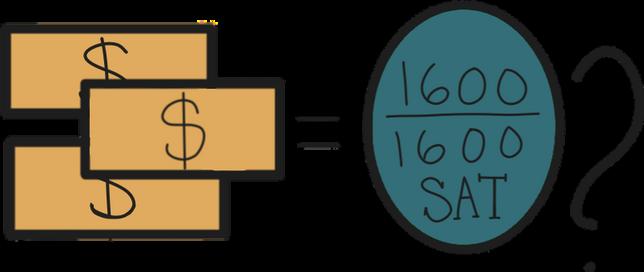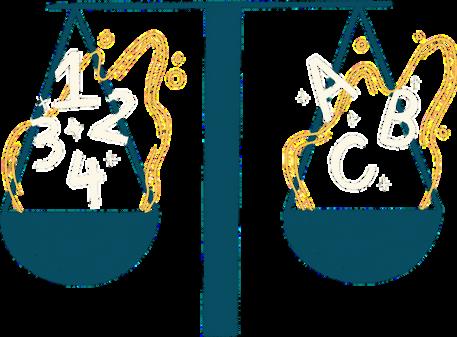
14 minute read
The quad (PP
from Vol 1 Issue 1
The QUAD contents
standardized testing - 14
Advertisement
Written by Kavya Gurunath, Vivian Wang
Edited by Melanie Calkins, Akshara Madabushi
Art by Nasiah Burns
Layout Design by Elena Fritz
Written by Melanie Calkins, Jaiden Wick
Edited by Stephanie Le
Art by Sahithi Lingampalli
Layout Design by Sahithi Lingampalli
Standards based grading - 18
falcon recomm club endations! - 20

Over the last year, the Universities of California system made headline news as they made standardized tests, such as the SAT and ACT, optional for application to their universities. This sparked a conversation over whether standardized tests should be used for college applications at all. Standardized testing for colleges was created after World War I and was intended to determine how ready a student was for college (Gilman, 2020). However, there are many drawbacks to these tests that have started to outweigh the advantages of standardized testing.
Socioeconomic Advantages
In a study done in 2013, researchers found that higher income families did better on the SAT than lower income families (Hess, 2019). In a 2015 analysis, it was found that students with a family income higher than $20,000 had higher averages on the SAT than those with a family income less than $20,000 (Hess, 2019).

NO NO NO
There are a couple of reasons for why wealthier students do better on standardized tests. The first is that they have the money to take the SAT or other standardized tests multiple times. The SAT costs $55 for the 2021-2022 school year (College Board, 2021). Students with a higher income can afford to take the test multiple times. Although there are fee waivers for students with a lower income, richer students are still more likely to retake the SAT multiple times.
In addition, those with higher income also have access to better funded schools, so their education might be of a better quality. They might also have access to more courses and tutoring that help you prepare for standardized tests that students with lower income can’t afford. This gives students with higher income families an inherent advantage when taking standardized tests. This is unfair to the lower income students who the standardized tests should favor just the same as higher income students (Hess, 2019).
Stress
Standardized testing is stressful. It feels like your entire future rides on this one test. While there are opportunities to retake, some students might not have the effort or time to take tests, such as the ACT and SAT, again. A study done on stress caused by standardized testing shows that there is a 15% increase in the level of cortisol (stress-causing hormone) in students that are about to take a standardized test than those who aren’t (Tatter, 2019). Stress might cause students to do worse on the test, making the test score an inaccurate reflection of the student’s ability.
Inaccurate Indicator
Standardized testing is supposed to indicate how ready a student is for college. Researchers, however, make the case that SAT and ACT scores don’t reflect student-readiness for college as well as other indicators, like high school GPA (Cooper, 2020). GPA reflects preparedness, ability to finish work on time, working hard over a long period of time, etc, which are all skills needed to succeed in college.
An SAT or ACT test score indicates how good you are at studying for one particular test, but doesn't say anything about working hard over long periods of time. So, standardized testing doesn’t even succeed in its main goal of indicating readiness for college.
All of these factors show why standardized testing should no longer be considered for college admissions. While it is supposed to put all students on an even playing field, there are inherent advantages that some students have over others when it comes to taking these tests. In addition, there are other factors that can be looked at when it comes to college admission, such as GPA, community service, etc. The SAT and ACT are no longer as effective as we think them to be. Maybe it is time to consider an alternative to standardized testing.



YES YES YES

In November, the University of California system announced that they would be extending their test-blind policy indefinitely. Critics, who have long maintained that testing is biased against low-income and underrepresented students, praised the move. (An admittedly rather small segment of) the public rejoiced — after all, students whose families netted over $100,000 were more than twice as likely as those below $50,000 to score 1400-1600 on the SAT (Kantrowitz, 2021). How horrid!
In isolation, standardized testing is unfair. Average scores in the under-$25,000 bracket lag behind the $100,000+ bracket by 120 points (Kantrowitz, 2021). So why, then, did the very same system’s Standardized Testing Task Force (STTF) declare in bold print that “The Task Force does not at this time recommend that UC make standardized tests optional”?
Contrary to mainstream criticism, they write that “standardized test scores help to identify and admit students who are members of historically excluded groups and/or first generation” and requested that the Academic Senate conduct more research about the potential effects of such a drastic policy change (UC Academic Council Standardized Testing Task Force, 2020). In particular, the STTF found that “factors other than standardized test scores disproportionately affect AfricanAmerican and Latino students in the state; second, that the standardized tests are valuable because they enable more accurate prediction within disadvantaged groups, of likely student outcomes; and third, that UC considers standardized test scores in admissions decisions, in the sense that comprehensive review helps to mitigate mean test score differences among groups” (UC Academic Council Standardized Testing Task Force, 2020).
To elaborate upon the third (and quickest): while certain schools like the University of Iowa offer automatic admission according to GPA and SAT/ACT scores, the vast majority of US colleges and universities practice holistic admissions. Among the University of California’s considered factors are “Quality of your academic performance relative to the educational opportunities available in your high school, ” and “Academic accomplishments in light of your life experiences and special circumstances” (UC Admissions, n.d.).
In other words, higher SAT scores are only strictly better than lower ones if all else is held equal.
But wait, someone particularly involved might note, Less than half of students from the bottom 20% attend any college at all, and 4 in 10 0.1%ers attend an elite school (Chetty et al., 2017). In theory, the gap is accounted for, maybe, but in practice, it’s not. The downside to holistic admissions is discerning what causes what in what amounts. If the disparity in admissions were solely caused by testing, every other factor must be perfectly equal.
They aren't.
Say we decide to boot testing in favor of course rigor — well, rural students have a 27.1% chance of attending a high school that offers no AP courses (35.3% of American Indian or Alaskan Native students) in comparison to 14.8% overall. This cannot be considered holistically the same way testing can: there is no way to identify a strong student in the absence of advanced coursework. (As an aside, when the ACT became required in Michigan high schools in 2007, “for every 1,000 lowincome students who had taken the test before 2007 and scored well, another 480 college-ready, low-income students were uncovered by the universal test, ” testing actually improving identification (Dyarnski, 2018)).
The less said about extracurriculars, the better.
If we tried GPA, we’d see that the effects of grade inflation don’t hit everyone equally — between 1998 and 2016, average GPAs in private schools jumped from 3.25 to 3.51; in suburban public schools, 3.25 to 3.36. In urban public schools, that number went from 3.26 to just 3.28 (Marcus, 2017). If a high school doesn’t report average GPA and colleges haven’t been able to track that high school’s graduates — especially likely for Title 1 schools that send fewer students to universities — what does admissions have to work with?
Testing is that data. While the STTF mentioned that UCs “may already use test scores in a manner unlike that of other institutions, ” the Massachusetts Institute of Technology also finds “that considering performance on the SAT/ACT…substantially improves the predictive validity of our decisions with respect to subsequent student success at the Institute” (Schmill, 2020).
The SAT (or ACT) is far from perfect — our education system is far from perfect — but it does not worsen equity. Its removal, on the other hand, will.

how beneficial is being graded on a scale of 1-4?
2020 granted two new situations for students; Covid, and the San Diego Unified School District standard based grading implementation. Two years later, Covid has changed the way students are being taught, while the standard based grading system has made a very large impact as well. PowerSchools Blog defines it as “the intention of teachers tracking their student’s progress in order to achieve their highest potential. ” With the 0100% scale changing into a 1-4 scale, and the fear students feel because of this change, , the importance of looking into the various benefits and downfalls is heightened.
As an A becomes a 4, a B becomes a 3, a C becomes a 2, and a D becomes a 1, “0”s, or F’s, are eliminated from the grading scale. Some would argue that eliminating the use of “0”s and replacing it with “incompletions” is less of a punishment to students and can contribute to their overall success. With this new grading system, priority shifts to the mastery of concepts, instead of just completion of work to get a grade. With “incompletions” , there is typically a given period where students are allowed to make up that work. They are given the opportunity of this time to gain up to what would be considered as a “B” letter grade. Thus, students are held more accountable for what they are learning as a whole instead of moving on directly after completing an assignment. With more chances at mastery, it is easier for students to achieve academic success with this 14 grading scale(i.e. retakes or recompletion of assignments). Regardless, there is always a flip side.
Despite the pros of standards based grading, most teachers and students are still confused by and against it. Most schools have grading programs that automatically calculate percentages into the grade book. Because of this, the 4 point scale is converted to a 100 point scale, nullifying the whole point of a 4 point scale(Lesson Lady, 2013). But, students and teachers alike have felt that a 100 point scale has more accurately represented mastery of a topic. On the other hand, the scale of 1-4 doesn’t have a 0 to represent when a student fails an assignment. The scale was purposefully designed 1
4 2
that way, so as to not discourage students, yet that idea doesn’t prepare them for the “real world” where deadlines are expected to be met (Lesson Lady, 2013). Additionally, 7th-12th graders have been working with the traditional A-F grading system their entire lives. Hearing that this whole system is changing can be discouraging for these , especially when their academics start to truly count for college applications. So, is the new system there to help students succeed, or is it leading to more failure?
From personal experience, there are more students in favor of traditional grading (0-100 scale) over standards based grading (1-4 scale). Due to all the time and effort put into the completion of homework, it’s logical to have that work contribute to one’s overall grade, yet that is not the case in the 1-4 scale. Standard based grading has placed more stress on students since their grades depend solely on tests. With the preexisting stress of testing environments, having extra pressure placed on students to perform well on tests can negatively affect their mental health and/or lead to lower scores. Mrs. Gay, a teacher at SRHS, explains that, “the district’s standards for a 4 fall into a category of knowledge we haven’t explored yet. ” The ideal grade (a 4) almost seems unattainable because, without the proper knowledge and education, an impractical learning environment is created. Overall, standard based grading is not the “desired utopia” the school district intended and is not universally supported by those who experience it.
Throughout this ongoing controversial issue, there’s the question of whether or not it’s worth fighting to bring back traditional grading. There are clearly a multitude of aspects to each grading system to consider. Which scale is more beneficial for the academic success and overall well-being of the students? Do you think it was a good idea that didn’t go according to plan, or should the new system stay? Which grading system do you prefer? Now it is up to the students and staff to make a stand.
219 3 1

GET INVOLVED! A Falcon Take on Clubs
Debate
Debate Club develops public speaking skills coupled with a useful aspect of conducting research and formulating well-prepared arguments. Beating other schools in debate tournaments is a great highlight of the club.
Debate Club both improves your public speaking skills and teaches you more about the world. When I went to my first debate, I was a bit scared of arguing and defending my points with my partner. Now, I'm much more confident in my public speaking skills and defending my ideas with solid evidence. Even doing research is fun, because you can use critical thinking to recognize bias, what evidence counters what point, and you can also just learn more about the world we live in. Topics I had never heard about before, I am now educated about because of the Debate Club.
CSF
The California Scholarship Federation, or CSF, is an amazing club to join in order to have your hard-earned grades and volunteering activities recognized. Each semester, they have application drives for all students if they meet the requirements. To be in CSF, a member must earn 10 CSF points, which correspond to their semester grades on their report card. They also have inactive and active membership for those who want to be recognized for their community service. If you want to do further research on the qualifications for the club, check out their website (you can access it through the club page on the SRHS website). I am personally in CSF and it motivates me to work harder in school. I also volunteer around San Diego and it is nice to be recognized for the hours I put in. This club is a great opportunity for students at Scripps and they have their next application drive in February of 2022. They are always looking for new members so see if you qualify for this amazing club. :)
Philosophy
The name is pretentious; they should've done the British secondary school thing and gone with philosophy society, really. The basic structure is topic overview — discussion questions shown — freefor-all. It's not necessarily a debate (but most of the time it is), and the point is to propose ideas, however out there, and think about them. Aaron, the president, likes to call it the "unsafest safe space on campus, " in the sense that everyone is told not to judge people for what they say in Philosophy Club, outside of it. Join because radicalism is cool and talking is fun.
You should absolutely join the South Asian Student Union, because it is a celebration of South Asian Culture. Not only do we do fun activities, but there are various fundraisers and donations all of which benefit the South Asian community. There are also cultural events like our Diwali Event in October, which was across all the different SASU clubs in San Diego. This club is really fun, so please join if you would like!
South Asian Student Union The Falcon Playhouse
At the Falcon Playhouse, students within Scripps Ranch High School can learn and be a part of the productions that are put on throughout the school year. Through after-school rehearsals and performances, many within the cast and crew often learn as they go, and often create lifelong bonds with each other through the supportive environment. Experience isn't a requirement as many people within the Falcon Playhouse have learned as they go, making it a comfortable learning environment. The end result is the combination of the hard work both actors and technicians have put in to be rewarded with a stellar performance!
Covers for Lives
Covers For Lives is a community service oriented club here at SRHS. They organize and participate in various drives in order to make our community a better place. Simple, but still fun and engaging, activities that relate to the club’s focus at the time take place at meetings. You are also able to gain community service hours by taking part in and helping at some club events and activities, which is a big plus!

